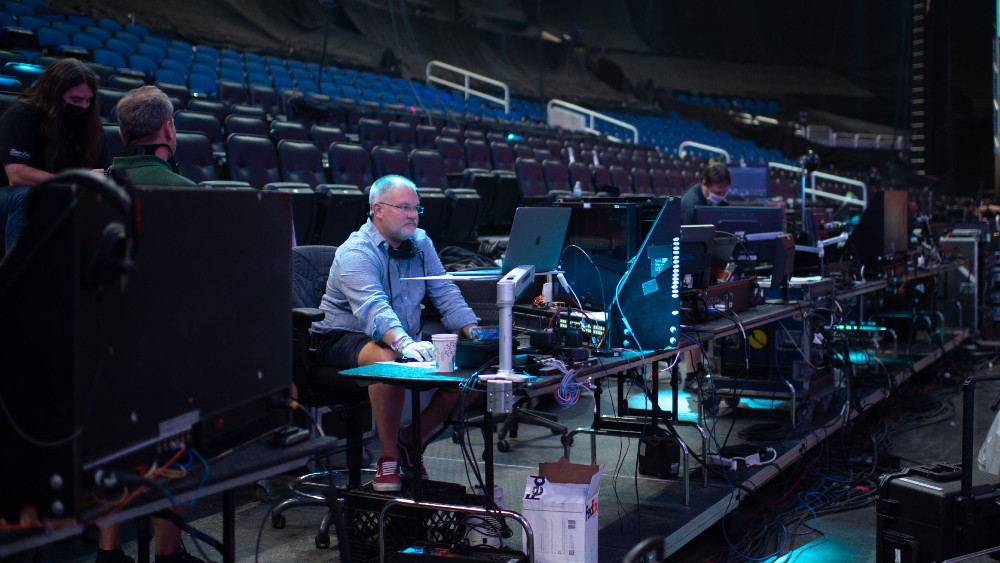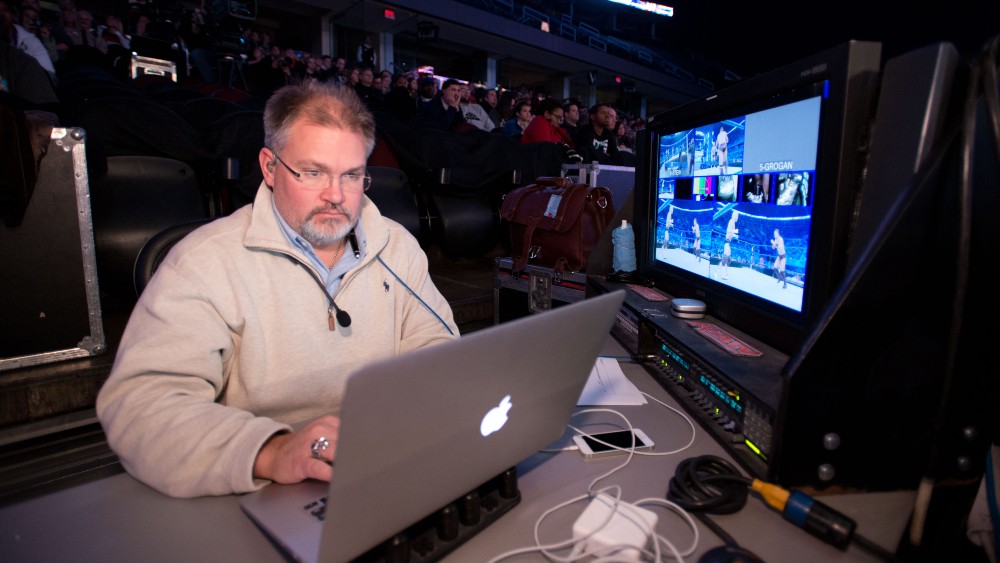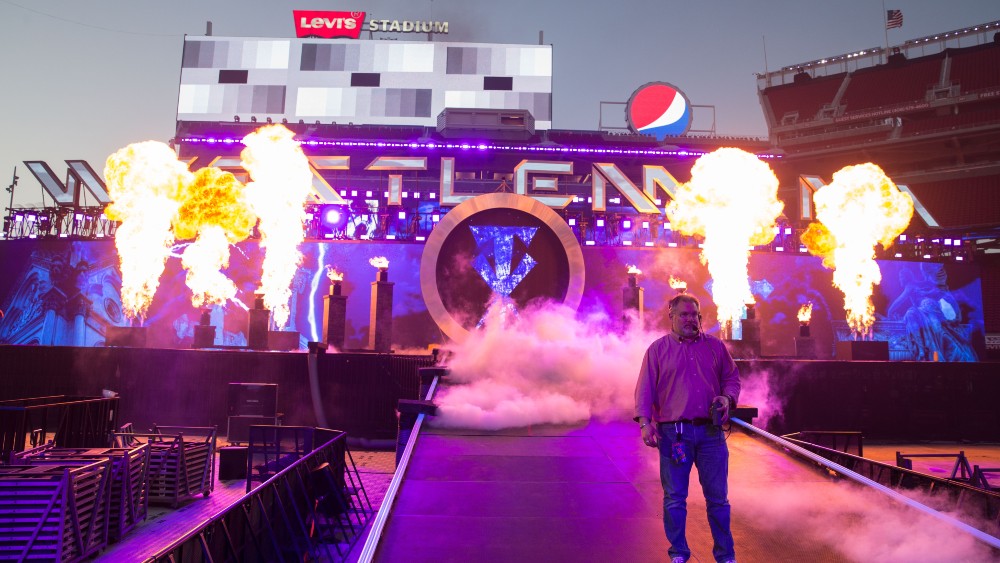
When you talk to almost any production designer working in movies or television, almost 90% of the time, their interest in designing sets goes back to their initial work in theater, even if it’s just in school or at a community theater. Although we frequently run interviews with production designers who work in the realm of film and television, there’s one avenue of television that just hasn’t gotten the amount of attention it probably deserves.
If you’ve ever seen one of the WWE’s Pay-Per-Views, but particularly the larger annual flagship shows like Wrestlemania and SummerSlam, it’s impossible not to be impressed by the sheer scale and scope of what’s being built for these events. When you look at the design of something like Elimination Chamber, a match where six superstars enter, one at a time from glass encasements, with no idea who will be next, you can tell there are some brilliant minds at work creating these.
Likewise, the impressive way that the WWE art department, electrical team and crew put on hundreds of live shows every year around the world with such amazing sets made Below the Line realize it was far past time we spoke to Jason Robinson, lead Production Designer for the WWE. We spoke to the company’s art department head not only about the WWE’s amazing traveling shows from pre-Covid, but also how the company pivoted during Covid for big events like Wrestlemania, and even before that, how they used technology to bring the fans back onto the shows.
But first, as is our tradition, we asked Robinson about his background before joining the WWE.
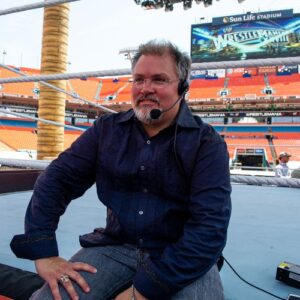
“Actually, I started out in theater and ended up doing some opera back in the day,” he told us. “I started school as a music education major, decided I didn’t want to do that, but was paying all my bills doing theater, so I was working for the opera companies in town and working in the theater, building sets and doing lighting and sound whatever I could get my hands on and continue doing that theater through college. At some point in college, one of the guys I was working with said, ‘Hey, man, you’ve got a good head on your shoulders, you should start looking at television.’”
Robinson started in television early enough to remember still using 16mm cameras, but that blended with his love for theater and scenic design. “I worked in the props department and worked in the carpentry department, and kind of blended that with some rock and roll even. We had an opportunity to go out on a couple of tours, and that blended all together. Truss and moving lights and cameras and decided at that point, this is where I wanted to be, more inside of that bigger entertainment, television lighting. Solid Gold was huge back then and watching the first iteration of moving lights and people like that and lighting and then MTV Music Awards was right around the corner after that, and seeing all those first lightning designers blending all of that together, is why I kind of went, this is a cool industry.”
One of the things that make WWE different from every other live television event, be it reality, talk show, game show or even other sports is that it is a traveling live show, or at least that was very much the case in the “before times.” If you watched Raw on one Monday, it was likely to be in a different city and stadium then when Raw aired live a week earlier or one week later. In that sense, it’s more like a touring rock show, except that once a month, and sometimes more, there would be a Pay-Per-View in a particular city which often required all new design concepts.
“I’ve travelled with the show since I started 26 years ago,” Robinson told us about his role in the touring aspect of WWE. “In a lighting position or lighting role, gaffer for the show, and as my role grew, the traveling grew with it. I continued to go with the show. Being part of the show, being part of the production design, we’re a fluid show, if you will, so our storylines, you design it once at the beginning of the year, and then you would travel a year’s worth or more with the tour. The set wouldn’t change, the lights wouldn’t change. But this is even less of a studio show. We had touring sets that changed per each show, so the SmackDown product set looks different from the Raw show, and then the Pay-Per-Views look totally different.”
“As far as the shows go themselves, you didn’t know what was going to happen that day — you didn’t know if you needed the cage or you’re going to do any kind of weird match that we would fall into or whatever the props department needed for the day,” Robinson explained about how things might change from show to show. “So little, tiny production design elements versus the really big ones. We’re going to do WrestleMania, or we’re going to do SummerSlam, or we’re going to do these really big elaborate sets for these big stadium shows. I continue to be with the tour, because that’s where that nucleus of the creative happens, if that makes sense. We’re all together on Mondays and Fridays, and you get most of your information and most of your meetings when we’re all together.”
This made us wonder how the WWE were able to tour those weekly show sets for Smackdown and Raw when presumably every arena space was different. “Our set has the ability to morph to the arenas, but most of the arenas are based around a professional hockey floor. So we know that if we ask the arena [about] the setup in hockey mode or concert mode, where it’s hockey floor with any of the retractable seats, we can put our set in. We know it’s 85 foot wide, 200 foot deep, and we can adjust that set, but you’re right. MSG [Madison Square Garden] has its own problems, especially with rigging and things like that. Barclays is a great center for us, it’s a little bit bigger than MSG.”
“You’d be surprised at the longevity of how certain things make it on the show,” he answered when asked how much of the set builds could be reused or recycled from one season to the next. “We give them a coat of paint and move on. We keep a lot of that stuff on the road, and it gets refurbished, but we have an 85-foot Statue of Liberty from WrestleMania XXIX, kind of hard to repaint or use for anything else, but she’s still there in our warehouse room, and all the letters from Wrestlemanias and the Xs from WrestleMania XXX. We do have a massive warehouse of old sets past.”
When COVID hit, WWE shifted into the Orlando Performance Center where matches would take place without an audience and then with wrestlers around the ring (mostly) cheering on their colleagues, but in August, WWE introduced a new way of getting back to the shows as they were: Thunderdome.
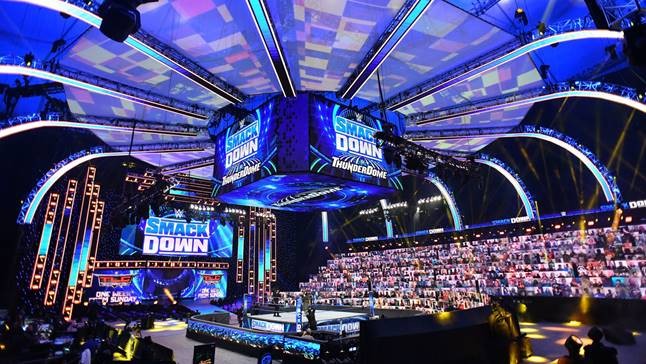
Taking over the Amway Center in Orlando, which normally holds a capacity of 20,000, Robinson and the engineering team set up thousands of LED monitors onto which members of the WWE fanbase would be projected. He explains how this went down to us. “We were in the Performance Center in Orlando for a very long time, which was fantastic, but we needed to get back to the show that looked like WWE — cameras in the right spot, entranceway in the right spot. We have a feng shui, if you will, a very organic feel to the way that you see the show on TV. Part of that show is 100% the audience, and it’s having the audience behind the cameras and seeing the audience behind the handheld shots and seeing the audiences pretty much in every shot you can. So to get back to that, our charge was like, ‘Hey, it looks like we can rent the Amway Center for an extended period of time until the NBA starts back again. How are we going to get fans in there?’”
That question led to an amazing and unprecedented technical achievement that allowed fans back into WWE matches, at least virtually, but also to be seen on the live shows.
“One of the charges that came to us is we wanted to make it feel like they were really in the stadium instead of on an LED board that’s just flat and hanging across with these populated faces. Our charge was to make it feel more real. I remember going to the stadium that same day, because we were stationed there in Orlando for that whole time. ‘I’m gonna run down to the arena if they’re open.’ We took cardboard boxes, a bunch of us, and [we] figured out where the seats would go. That was the first challenge. ‘Can we do it? Sure.’”
“Now we got our CADs [Computer-aided Design], and everybody started drawing, and I started drawing how it was gonna fit,” he continues. “The next question was how we’re going to facilitate however much more gear we’re gonna have. That’s all 7mm LEDs back there. We pretty much cleaned out Screenworks L.A., all their 7mm. I told them how many panels we needed, and we ran several trucks from California over with LED and LED and more LED. That took us about two weeks to load in — we had to hand-carry all that up, figuring out this truss structure that had in the seats, and then came the next [question]: How are we going to put audiences on it? How were they going to look real, so they weren’t going to be too big or too small? And how many additional sets of gear guys and crew we’re going to have to do it. We staffed up a lot. I think a lot of our vendors were surprised in August of last year, how many more people we needed.”
COVID and the lack of audiences did have one huge benefit–less people means MORE PYRO!
“We have a great Pyro designer, Ed Romack. He is with Strictly FX, and right now, we are in a wonderful phase. Without any fans, he is loving life. He can put pyro anywhere he wants to, as close to elements that he can get, and we’ve got almost a 360-degree pyro show happening right now. We can fly it, we can hang it over what would be the virtual audience in our Thunderdome. We’re layering it up the virtual audience behind the LED board, so he’s got all the toys right now and lasers, another thing that now we can point him anywhere. We have an abundance of great laser cues and great pyro cues, all led by Ed.”
Eventually, our conversation turned to Wrestlemania XXXVII, which took over the pirate theme premise that was previously going to be the theme for the previous year’s show. But first, the WWE had to deal with the COVID shutdown.
“WrestleMania XXXVII, for us, was very odd,” Robinson says with no sense of exaggeration. “COVID had just shut the world down almost five weeks before WrestleMania was supposed to air, so we were in a good groove, we’d done our site survey. The date we actually shut down and said we’re not going to our next city, it was a Thursday, and I was in Tampa at the stadium doing one of my final walkthroughs, thinking that in two weeks, we’ll be moving in. We’re getting the calls. We’re talking to the building at Raymond James [Tampa Stadium]. I actually had to cancel my flight, got a rental car and drove to Orlando. We were so close, and I think that was sort of the oddest thing, just everybody shelving all of their stuff. Most of the vendors had some trucks loaded, some trucks were at the venue.
That led to a year later, planning for #37. “After a year of sitting, it was kind of old home week,” the production designer opines. “It was like putting on the jacket you haven’t worn all summer, but then it starts creeping in, ‘Well, you can’t put this here, because we have to put audience there. We have to have more lines over here, so that can’t travel this way. You can put your power from this way, because we’re gonna have to queue people back here where we weren’t going to queue them before. It was a little bit of a head scratcher to figure out how we were going to physically work in the COVID world and then make the show look awesome [without the] 80,000 people that we thought we were going to have a year before and still make it look full and still make it an exciting experience for them even though they’re socially distanced. I can tell you that they were loud — with half the audience, we’re still as loud as the 80,000. I think they were ready to get back to having fun.”
As planned last year, this year’s Wrestlemania would be taking place at the home of the Tampa Bay Buccaneers, and as luck would have it, the Buccaneers just won the Super Bowl a few months prior. So now you have one of the biggest sports events of the year followed by another big sports event taking place in the home of the winners, so that theme perfectly matched up on many levels.
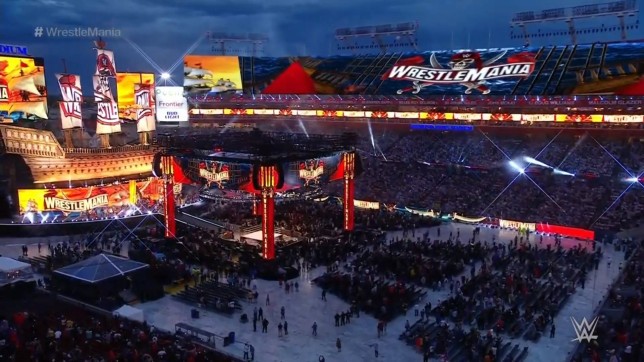
Being in the Buccaneers’ home only partly contributed to the original idea for the show’s pirate theme, though, and many plans changed from Wrestlemania XXXVI to XXXVII.
“There’s a depth of staff at the WWE — we have Creative Services, Mr. McMahon has his own plan for the way the show looks. I think overall, it was just a bigger Genesis,” Robinson says. “It wasn’t like an ‘aha’ moment where we go, ‘Ah, I’ve got this really good idea — let’s do pirates.’ It was sort of ‘We’re going to do pirates,’ [and then] we all kind of felt that move towards it. The graphics department worked on the original flag and then changed into the skull and crossbones for the second thing, so we did go through two themes there. We had started some of the set elements you saw for WrestleMania sort of in our minds. But then we changed the graphics, we changed a lot of that. ‘Oh great, we’re going to do pirates, but wait, we’re not going to do it the way we were going to do it before.’ A lot of that was the COVID, because we had a lot of our superstars up in a different location, and the way we’re going to lay out the way they were going to play, I think some of that played into having to rethink our set looked and how our presentation of that WrestleMania was going to be.”
“For our inspiration, obviously, you can’t go anywhere without thinking of some of those old pirate movies,” he said about the influences for the company’s biggest show of the year. “Obviously, you’ve got the Pirates of the Caribbean, but [the Black Pearl] was a black boat and that was very stylized. We wanted our ship to have a different vibe. When we thought, ‘Let’s do a pirate ship,’ the idea was to build our own, and I think everybody was floored when they saw how big it was. I drew from different pirate ships, looking at old movies and photos, not even pirate ships but more galleons in that respect. If you look at the back, they had the big captain’s quarters. We wanted to have a really amazing pirate ship that you can think is fully active and fully working, especially with the cannons. If you noticed, we had all the pyro in the cannons. That was one of the things Ed and I immediately wanted to do was shoot off the cannons every night. We had 50 cannons on the ship.”
After discussing Wrestlemania, it was back to where WWE goes from here, and apparently, the show being on the road again will resume soon enough.”We’re heading out on the road come July 16. We’re coming out in Houston, Texas on SmackDown, then we’re headed right into our Pay Per View, Money in the Bank, which is one our favorite Pay Per Views of the year. Lots of ladders with a briefcase hanging over the ring, so we have two Money in the Bank briefcases and onto Dallas and then we’re not looking back. We’re headed forward, so we’re looking at new sets, new staging that we’re building. My next phone call is to the graphics department, talking about augmented reality and how AR is going to interface with our set, and how we’re going to make some really cool graphics for set entrances as our superstars enter.”
But there’s even more… “I think it was just announced this past weekend on NBC that we’re having SummerSlam in Las Vegas on August 21, and man, that is going to be huge. It’s going to be our first SummerSlam in a stadium since Wembley, years and years ago [in 1992]. The next phone call after that, we’re going to talk about a roof structure that we’re going to put in at Allegiant Stadium.”
Out of curiosity, we asked Robinson how he felt when WWE superstars begin destroying or throwing competitors through the sets his team has built. “The first 200 times they did it, I still cringed, but the callus has grown pretty solid now,” he says with a chuckle. “I’m used to it. When I’m in the arena, our production staff all sit right underneath the cameras, but every once in a while, you’ll see the guy standing on stage, and you’ll see the one producer start waving at me, and I’m like, ‘Here they go. They’re gonna want to throw somebody through the set again.’ Yeah, I do hate it, but I think anything for the story at that point leads to fans turning on the show every week.”
Before wrapping, we hoped to learn more about how WWE was integrating VR into the live shows to continue the virtual experience of something like Thunderdome. “We’ve started a little bit, especially during Thunderdome, there has been some AR [augmented reality] brought into it. We’re moving into a lot more AR, where you see the 3D elements that cameras can walk around. We were doing some testing this past week with a Steadicam version of that. The XR world — and I don’t know how much you’re familiar with that — we’ve done some XR stuff, but it’s not been in house. We’ve done some of our promos and stuff in XR environments, but from a touring point of view, I think we’re just going to stay with sets and lights and trucks and AR. We’re moving forward with AR, hopefully, multiple cameras will look at it from multiple different viewings. We’re really excited, and we’ve got a good plan. I don’t want to spill the beans. We’re definitely moving toward an AR environment for our television show.”
Robinson concluded by mentioning how glad he was to finally have a chance to speak with Below the Line. “All of our production staff come from people like me from theatres and rock ‘n’ roll guys, television production and single-camera production. A lot of our backstage lighting guys all came from movies and TV shows. So you look at us, and we’re pretty much a snapshot of the industry. Even though our product doesn’t maybe doesn’t go along with Friends or something like that, I think we are a lot of below the line guys that are all doing the same job.”
You can see all the amazing work done by Robinson and his team, including episodes of Thunderdome, and of course, Wrestlemania XXXVII, on Peacock where an archive of past WWE shows and Pay-Per-Views are maintained from the former WWE Network.
WWE has submitted the following for Emmy consideration:
WrestleMania 37:
Outstanding Variety Special (Live)
Outstanding Directing for a Variety Live Special
Outstanding Production Design for a Variety Special
Outstanding Sound Mixing for a Variety Special
WWE ThunderDome:
Outstanding Achievement in Engineering Development
All photos courtesy WWE. Thanks to Stefanie G. Fiondella, WWE VP of Communications, for Lee Meltzer for their help facilitating this interview.

